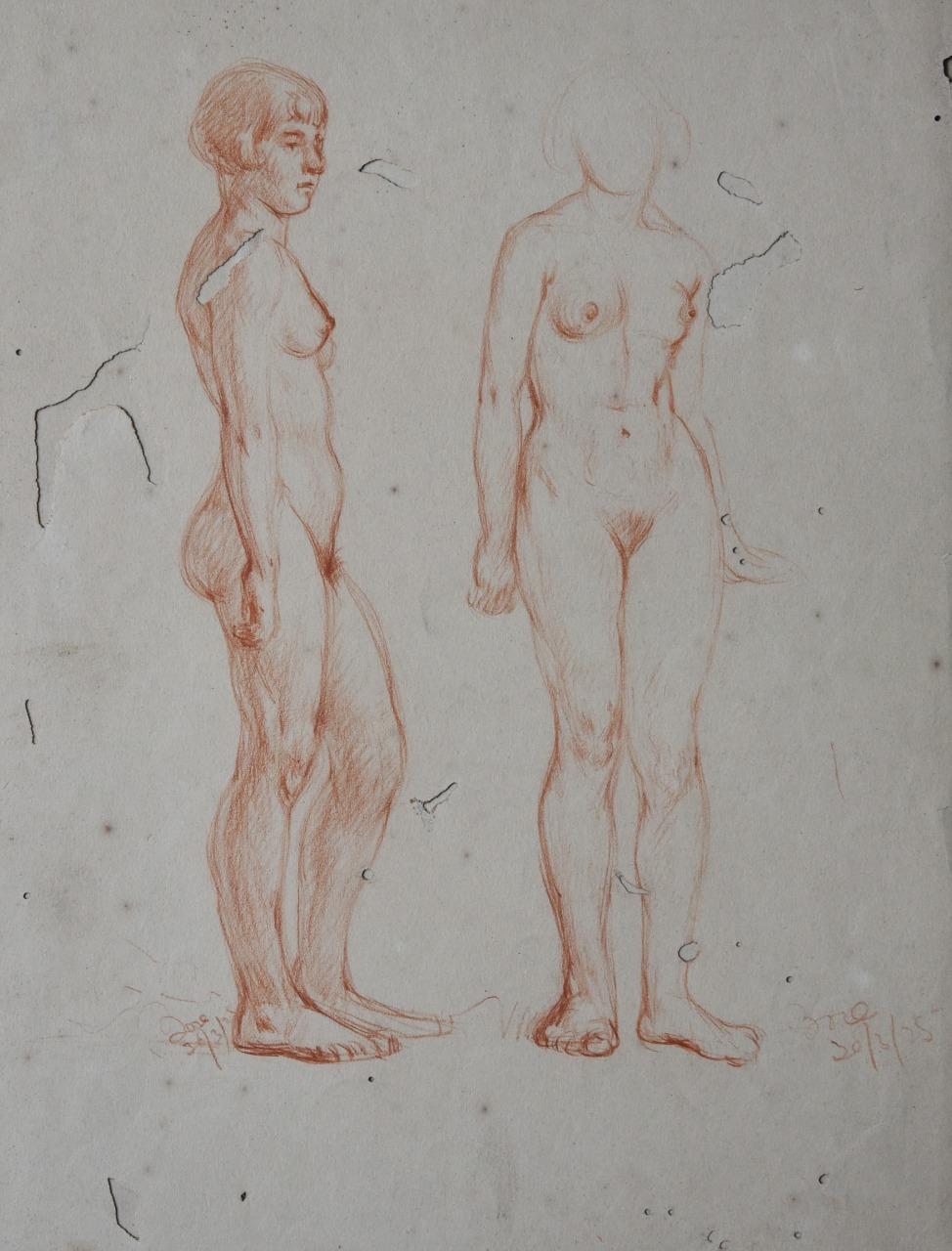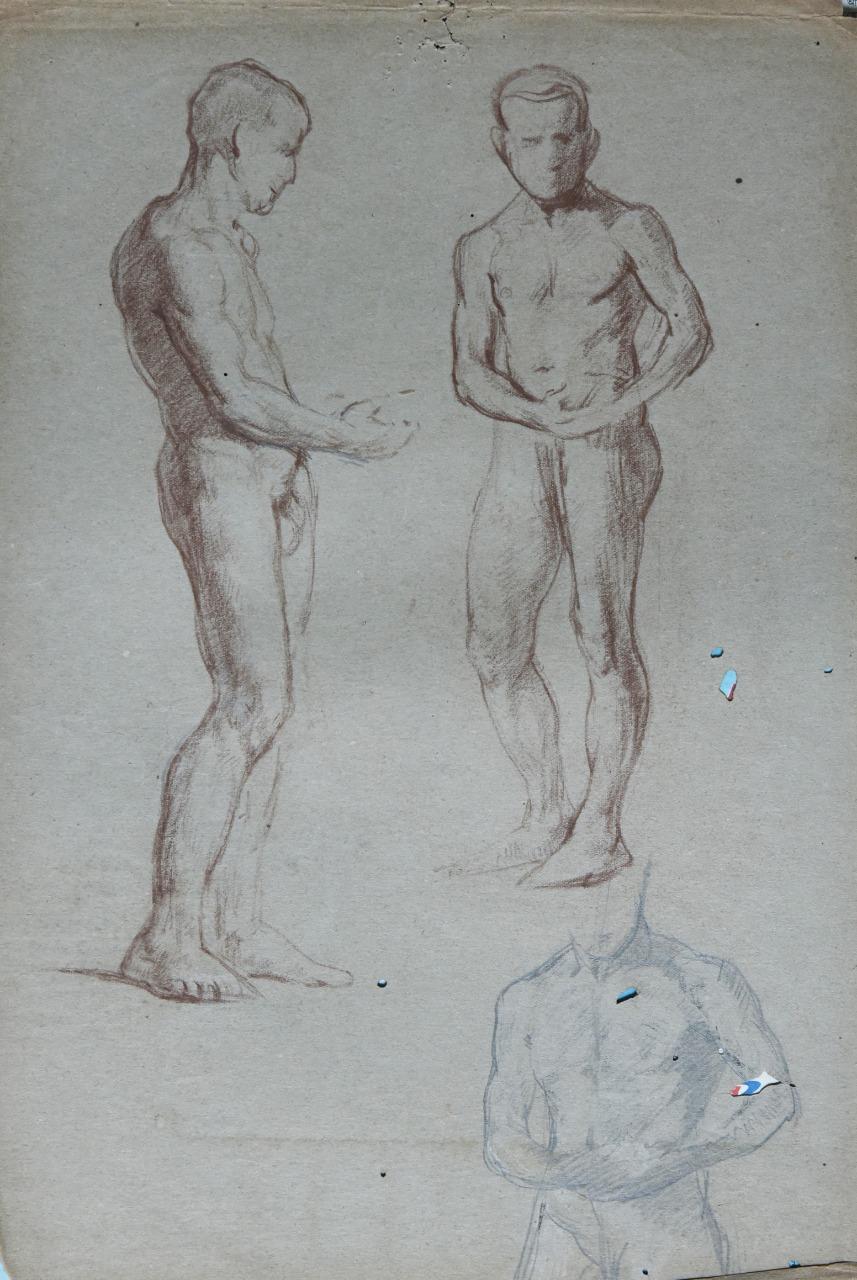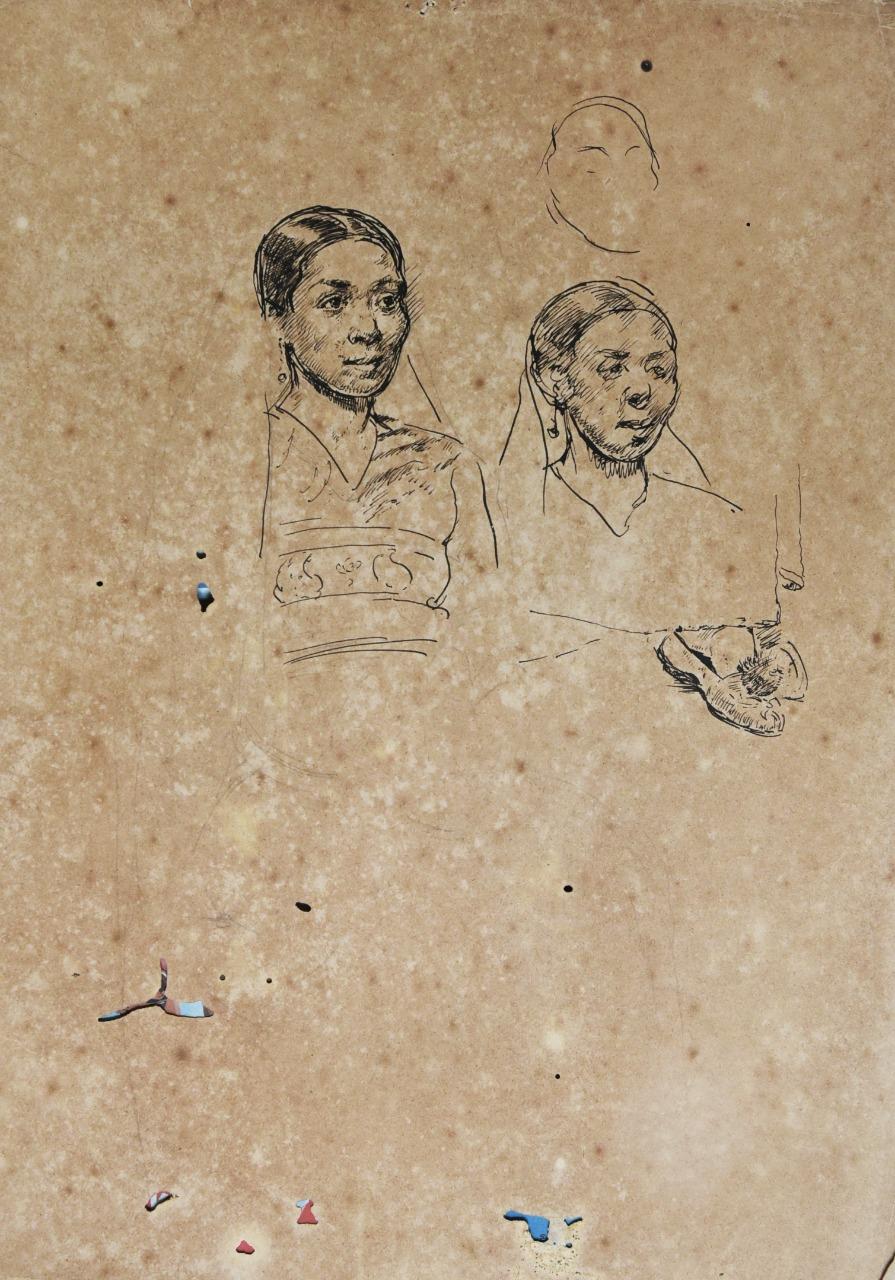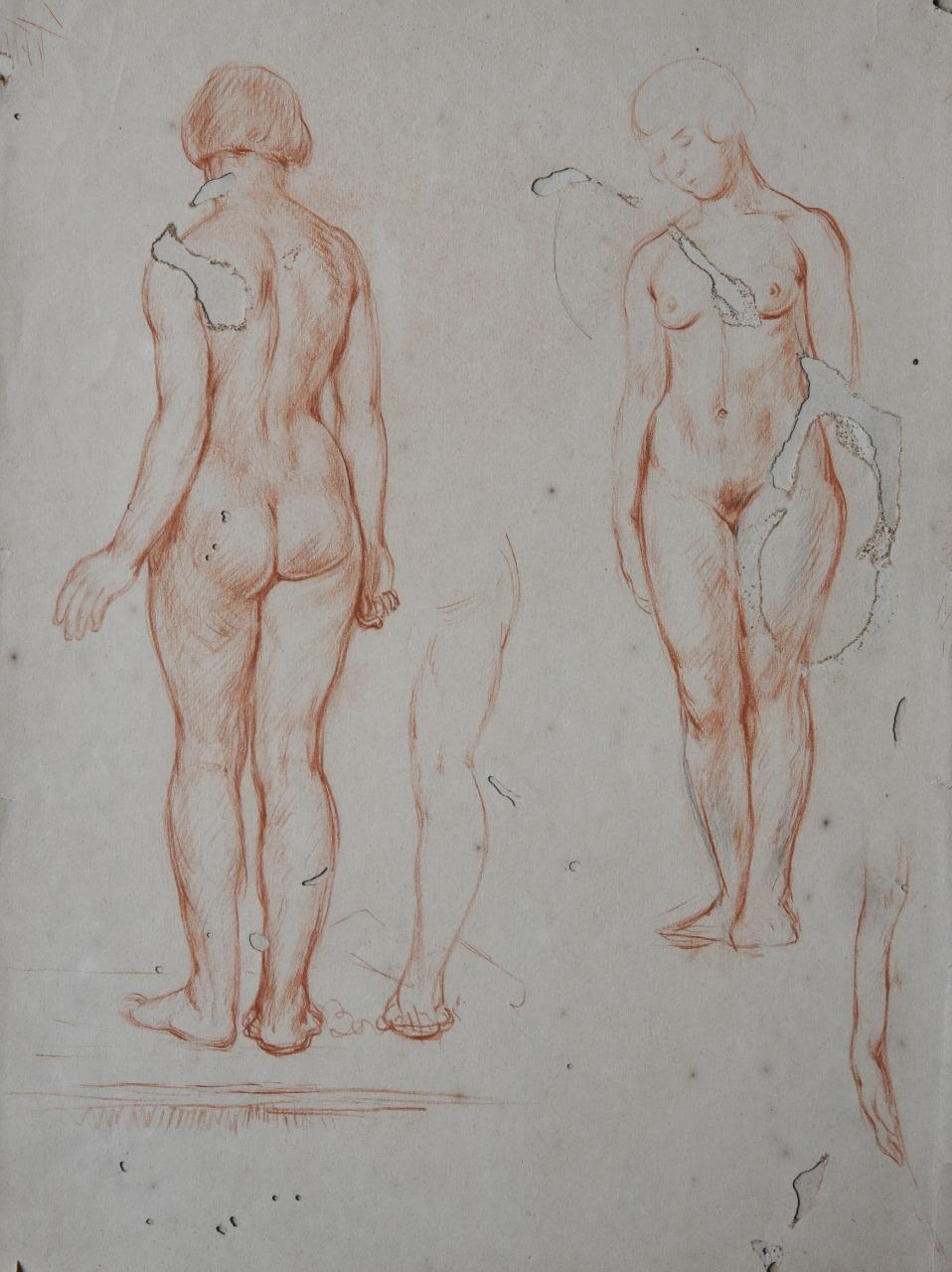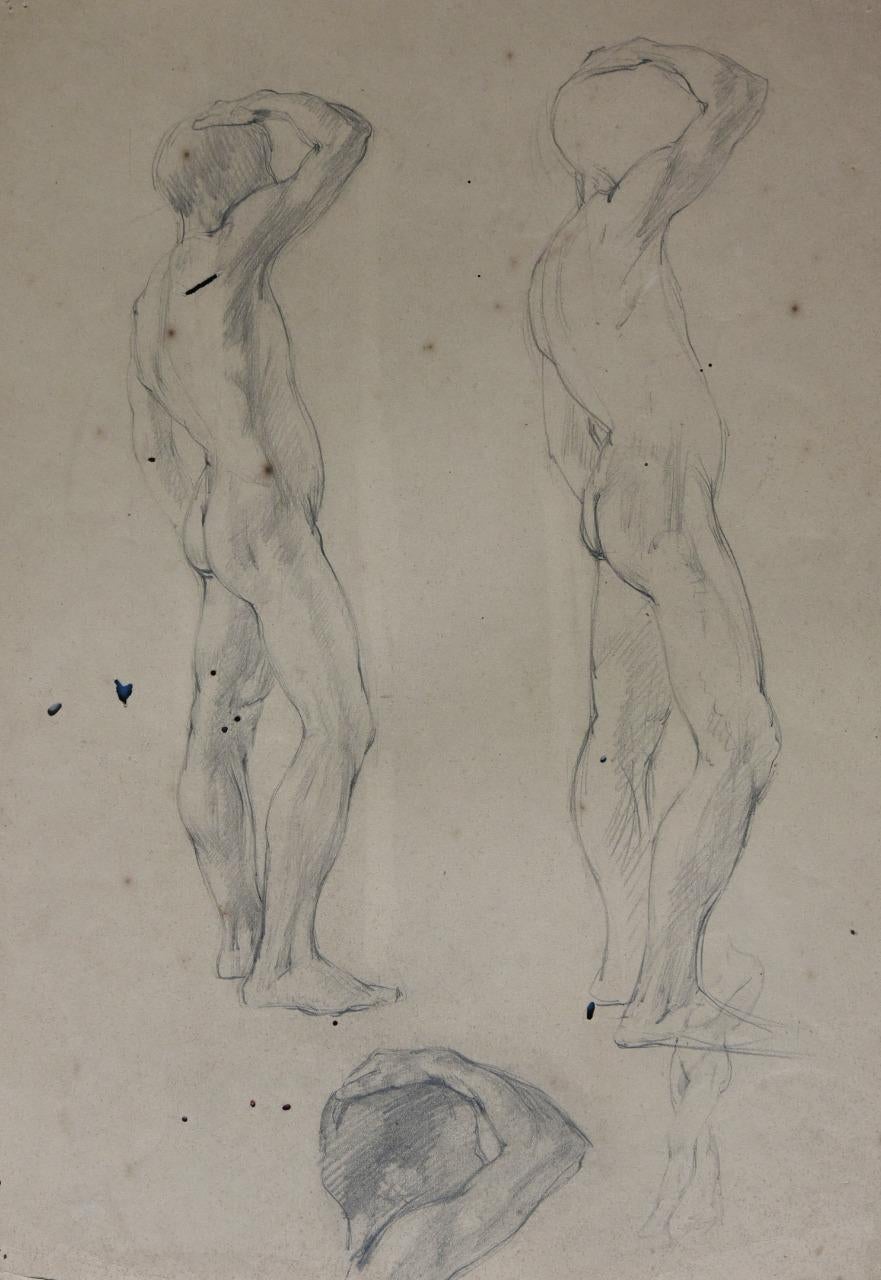Items Similar to Illustration for the Fruit of Destiny with a Beggar, Ink on Paper "In Stock"
Want more images or videos?
Request additional images or videos from the seller
1 of 10
Badri NarayanIllustration for the Fruit of Destiny with a Beggar, Ink on Paper "In Stock"1985
1985
About the Item
Badri Narayan - Illustration for the Fruit of Destiny with a Beggar - 7.25 x 8.5 inches ( unframed size)
Ink on paper
Inclusive of shipment in ready to hang form.
Style : The artist’s paintings are narrative, and titles like ‘Queen Khemsa’s Dream of Hamsa’ and ‘Meeting at Midstream’, are the starting points from where one must unravel the complexities presented by the paintings, in order to interpret and understand them. Symbolism is a recurring feature of his works, though sometimes, he also uses popular icons of Indian culture like Ganesha. He explains, “I have picked up the imagery that surrounds me, the one I am born into, and it comes naturally.” Narayan draws heavily from Indian mythology and metaphors and acknowledges the influence of the Indian miniature tradition in his works. The artist believes in the two-dimensionality of painting, and prefers to work in a smaller format; one that he finds practical and well suited for the watercolours that have been his preferred medium for several years. Narayan has also worked with etchings, woodcuts and ceramics and illustrated some children’s books.
About the Artist and his work :
Born :Badri Narayan was born (1929-2013) in Secunderabad, Andhra Pradesh.
Art Career :
The self-taught artist Badri Narayan has been painting for over 45 years. During this time, he has worked as an art teacher and an artist, but has always remained a deeply introspective individual. This self-reflection and autobiographical perspective is the most constant theme in Narayan’s work.
Solo Exhibition :
Narayan’s first solo exhibition of paintings was held at the Hyderabad Art Society in 1954. Since then, he has held well over fifty solo shows including several exhibitions at Pundole Art Gallery, Mumbai. He has also exhibited his work at Mon Art Gallerie, Kolkata; Sakshi Art Gallery, Bangalore; and Jehangir Art Gallery, Mumbai.
Shows :
1966-67 - The 5th International Biennale of Prints, Tokyo;
1961 - The 2nd International Biennale, Paris.
Honours and Awards :
1990 - Maharashtra GouravPuruskar, Maharashtra State Government;
1987 - Padma Shri, Government of India;
1984-86 - Senior Fellowship for Outstanding Artists, Government of India, New Delhi;
1968-69 - ‘The Critics’ Award’, Artists’ Centre, Mumbai;
1965 - National Award, Lalit Kala Akademi, New Delhi;
1949,54,60,62 - Gold Medal, Hyderabad Art Society, Hyderabad.
- Creator:Badri Narayan (1929 - 2013, Indian)
- Creation Year:1985
- Dimensions:Height: 15.25 in (38.74 cm)Width: 16.5 in (41.91 cm)Depth: 1 in (2.54 cm)
- Medium:
- Movement & Style:
- Period:
- Condition:
- Gallery Location:Kolkata, IN
- Reference Number:1stDibs: LU60434765282
About the Seller
4.9
Vetted Seller
These experienced sellers undergo a comprehensive evaluation by our team of in-house experts.
Established in 2004
1stDibs seller since 2017
119 sales on 1stDibs
Typical response time: 23 hours
- ShippingRetrieving quote...Ships From: Kolkata, India
- Return PolicyA return for this item may be initiated within 7 days of delivery.
More From This SellerView All
- Royal Academy Series-4, Conte on Paper, Modern Artist Atul Bose "In Stock"Located in Kolkata, West BengalAtul Bose - Royal Academy Series-4 Conte on Paper, 15 x 11.2 inches (Unframed Size) 1924-26 (Delivered Unframed in as is condition) Atul Bose was a master artist whose creative journey spanned several decades and left an indelible mark on the Indian art scene. He was born in 1898 in a small village in Bengal and showed an early aptitude for art. Despite facing financial difficulties, he pursued his passion and enrolled in the Government School of Art in Calcutta. Bose's early works were influenced by the Bengal School of Art, which was a movement that sought to revive traditional Indian art forms. However, over time, Bose developed his own unique style that blended elements of Indian art with European modernism. He was particularly influenced by the works of artists like Paul Cezanne and Georges Braque. Bose spent two years, 1924-6, at the Royal Academy. He was heavily influenced there by the post-impressionist Walter Sickert. He refused an invitation to help decorate the pavilion at the British Empire Exhibition in 1924 with Mukul Dey...Category
1920s Modern Figurative Drawings and Watercolors
MaterialsPaper, Ink, Pen, Conté
- Royal Academy Series-7, Conte on Paper, Modern Artist Atul Bose "In Stock"Located in Kolkata, West BengalAtul Bose - Royal Academy Series-6 Pencil on Paper, 15 x 11.2 inches (Unframed Size) 1924-26 (Delivered Unframed in as is condition) Atul Bose was a master artist whose creative journey spanned several decades and left an indelible mark on the Indian art scene. He was born in 1898 in a small village in Bengal and showed an early aptitude for art. Despite facing financial difficulties, he pursued his passion and enrolled in the Government School of Art in Calcutta. Bose's early works were influenced by the Bengal School of Art, which was a movement that sought to revive traditional Indian art forms. However, over time, Bose developed his own unique style that blended elements of Indian art with European modernism. He was particularly influenced by the works of artists like Paul Cezanne and Georges Braque. Bose spent two years, 1924-6, at the Royal Academy. He was heavily influenced there by the post-impressionist Walter Sickert. He refused an invitation to help decorate the pavilion at the British Empire Exhibition in 1924 with Mukul Dey...Category
1920s Modern Figurative Drawings and Watercolors
MaterialsPaper, Conté, Ink, Pen, Pencil
- Royal Academy Series-3, Pen & Ink on Paper, Modern Artist Atul Bose "In Stock"Located in Kolkata, West BengalAtul Bose - Royal Academy Series-3 Pen & Ink on Paper, 15 x 11.2 inches (Unframed Size) 1924-26 (Delivered Unframed in as is condition) Atul Bose was a master artist whose creative journey spanned several decades and left an indelible mark on the Indian art scene. He was born in 1898 in a small village in Bengal and showed an early aptitude for art. Despite facing financial difficulties, he pursued his passion and enrolled in the Government School of Art in Calcutta. Bose's early works were influenced by the Bengal School of Art, which was a movement that sought to revive traditional Indian art forms. However, over time, Bose developed his own unique style that blended elements of Indian art with European modernism. He was particularly influenced by the works of artists like Paul Cezanne and Georges Braque. Bose spent two years, 1924-6, at the Royal Academy. He was heavily influenced there by the post-impressionist Walter Sickert. He refused an invitation to help decorate the pavilion at the British Empire Exhibition in 1924 with Mukul Dey...Category
1920s Modern Figurative Drawings and Watercolors
MaterialsPaper, Ink, Pen
- Royal Academy Series-3, Pen & Ink on Paper, Modern Artist Atul Bose "In Stock"Located in Kolkata, West BengalAtul Bose - Royal Academy Series-3 Pen & Ink on Paper, 15 x 11.2 inches (Unframed Size) 1924-26 (Delivered Unframed in as is condition) Atul Bose was a master artist whose creative journey spanned several decades and left an indelible mark on the Indian art scene. He was born in 1898 in a small village in Bengal and showed an early aptitude for art. Despite facing financial difficulties, he pursued his passion and enrolled in the Government School of Art in Calcutta. Bose's early works were influenced by the Bengal School of Art, which was a movement that sought to revive traditional Indian art forms. However, over time, Bose developed his own unique style that blended elements of Indian art with European modernism. He was particularly influenced by the works of artists like Paul Cezanne and Georges Braque. Bose spent two years, 1924-6, at the Royal Academy. He was heavily influenced there by the post-impressionist Walter Sickert. He refused an invitation to help decorate the pavilion at the British Empire Exhibition in 1924 with Mukul Dey...Category
1920s Modern Figurative Drawings and Watercolors
MaterialsPaper, Ink, Pen
- Royal Academy Series-4, Conte on Paper, Modern Artist Atul Bose "In Stock"Located in Kolkata, West BengalAtul Bose - Royal Academy Series-4 Conte on Paper, 15 x 11.2 inches (Unframed Size) 1924-26 (Delivered Unframed in as is condition) Atul Bose was a master artist whose creative journey spanned several decades and left an indelible mark on the Indian art scene. He was born in 1898 in a small village in Bengal and showed an early aptitude for art. Despite facing financial difficulties, he pursued his passion and enrolled in the Government School of Art in Calcutta. Bose's early works were influenced by the Bengal School of Art, which was a movement that sought to revive traditional Indian art forms. However, over time, Bose developed his own unique style that blended elements of Indian art with European modernism. He was particularly influenced by the works of artists like Paul Cezanne and Georges Braque. Bose spent two years, 1924-6, at the Royal Academy. He was heavily influenced there by the post-impressionist Walter Sickert. He refused an invitation to help decorate the pavilion at the British Empire Exhibition in 1924 with Mukul Dey...Category
1920s Modern Figurative Drawings and Watercolors
MaterialsPaper, Ink, Pen, Conté
- Royal Academy Series-6, Pencil on Paper, Modern Artist Atul Bose "In Stock"Located in Kolkata, West BengalAtul Bose - Royal Academy Series-6 Pencil on Paper, 15 x 11.2 inches (Unframed Size) 1924-26 (Delivered Unframed in as is condition) Atul Bose was a master artist whose creative journey spanned several decades and left an indelible mark on the Indian art scene. He was born in 1898 in a small village in Bengal and showed an early aptitude for art. Despite facing financial difficulties, he pursued his passion and enrolled in the Government School of Art in Calcutta. Bose's early works were influenced by the Bengal School of Art, which was a movement that sought to revive traditional Indian art forms. However, over time, Bose developed his own unique style that blended elements of Indian art with European modernism. He was particularly influenced by the works of artists like Paul Cezanne and Georges Braque. Bose spent two years, 1924-6, at the Royal Academy. He was heavily influenced there by the post-impressionist Walter Sickert. He refused an invitation to help decorate the pavilion at the British Empire Exhibition in 1924 with Mukul Dey...Category
1920s Modern Figurative Drawings and Watercolors
MaterialsPaper, Ink, Pen, Conté, Pencil
You May Also Like
- "Men at the Seattle Public Market" (Two Figures)By Mark TobeyLocated in Missouri, MOMark Tobey "Men at the Seattle Public Market" (Two Figures) 1958 Ink and Tempera on Silk Signed and Dated Lower Left *This is a rare and important work. See attached images with book...Category
Mid-20th Century Modern Figurative Paintings
MaterialsInk, Tempera, Silk
- Americana Farmer and Wife, Gouache Painting WPA Art William Gropper WoodchopperBy William GropperLocated in Surfside, FLWilliam Gropper Original Gouache on Paper depicting man carrying an axe and woman carrying basket walking together. Hand signed lower right Fra...Category
Mid-20th Century Modern Figurative Paintings
MaterialsInk, Watercolor, Gouache
- Americana, Lawyer in Court, Politician, Gouache Painting WPA Art William GropperBy William GropperLocated in Surfside, FLWilliam Gropper Original Gouache on Paper Hand signed lower right 33.5 x 27.5 image 26 x 20.5 The New-York born artist William Gropper was a painter and cartoonist who, with caricature style, focused on social concerns, and was actively engaged in support of the organized labor movement throughout his career. This original watercolor drawing is done in the iconic style of the artist's oeuvre. Born to Harry and Jenny Gropper in 1897, William was raised in New York City's Lower East Side. His parents were Jewish immigrants from Romania and Ukraine, and young William grew up in relative poverty, watching his family struggle to achieve that sought-after American dream. His father, a bright and college-educated man, was unable to find employment that worthy of his intellect. His mother, meanwhile, worked as a seamstress from home. Coupled with the devastating loss of an aunt to the infamous Triangle Factory fire of 1911, significant childhood factors created the foundation that led to Gropper’s exploration of the American experience. Early on, Gropper displayed an extraordinary, natural skill for art. By 1912, he was already studying under the instruction of George Bellows and Robert Henri at the Ferrer School in Greenwich Village. During his time at school, Gropper was also awarded a prestigious scholarship to study at the National Academy of Design. However, he refused to fit into convention and was swiftly expelled from the Academy. After his expulsion, Gropper returned home to help financially by assisting his mother and taking a shop position. However, he didn't abandon art academia and soon presented a portfolio to the New York School of Fine Art which earned him a scholarship for study. Gropper obtained his first significant job as a cartoonist for the New York Tribune in 1917. While working as a staff cartoonist for the Tribune, he also contributed drawings to publications like Vanity Fair, New Masses, The Nation, and Freiheit. His interest in the welfare of the American worker, class inequality, and social injustice was central in his work. After publishing the graphic novel Alley Oop in 1930, Gropper's illustration career extended well into the decade. However, he was never exempt from controversy, and his 1935 Vanity Fair cartoon; prompted anger from the Japanese government. As an involved labor organizer and Social Realist activist, Gropper continued to bring attention to his radical reputation with visits to the Soviet Union and Poland. However, his concern with European politics and U.S. social causes didn't slow down his artistic career, and by the late 1930s, he had produced significant murals for American cities like Washington D.C. His 1938 mural Construction of a Dam was commissioned for the Department of the Interior and represents the Social-Realism style that depicts experiences of the worker and everyday societal life. Measuring at a staggering 27ft by 87ft, the piece portrays muscular, robust American laborers scaling rocky hillsides, building infrastructure, and operating heavy machinery. The mural feels undeniably American with golden scenery, denim blues, and steely gray colors. Gropper fits perfectly into Social-Realism because the style exhibits an illustrative flair with strong lines and simple, bold hues. The inspiration for Construction of a Dam sprang from his 1937 travels to the poverty-stricken Dust Bowl area. The trip was sponsored by a Guggenheim Foundation Fellowship, and his drawings of the Grand Coulee and Boulder Dams...Category
Mid-20th Century Modern Figurative Paintings
MaterialsInk, Watercolor, Gouache
- Andrew (Sitting), Mixed media on Pergamenata parchmentBy Howard TangyeLocated in London, GBHoward Tangye (b.1948, Australia) has been an influential force in fashion for decades. Lecturing at London’s Central Saint Martins for 35 years, including 16 years as head of BA Wom...Category
2010s Contemporary Figurative Drawings and Watercolors
MaterialsIndia Ink, Mixed Media, Oil, Acrylic, Watercolor, Gouache, Archival Pape...
- Mariano´s things Bottles Watercolor Drawing Mariano MartínLocated in Madrid, ESI always look for the same: THINGS, things that despite being normal, how beautiful: NORMAL THINGS!!! Normal things that, if we notice them, we breathe a few seconds and we let the h...Category
2010s Figurative Drawings and Watercolors
MaterialsPaper, Ink
- Mariano's Things 05 Mariano Martin Flower Vase Pink Watercolor DrawingLocated in Madrid, ESI always look for the same: THINGS, things that despite being normal, how beautiful: NORMAL THINGS!!! Normal things that, if we notice them, we breathe a few seconds and we let the h...Category
2010s Figurative Drawings and Watercolors
MaterialsPaper, Ink, Watercolor
Recently Viewed
View AllMore Ways To Browse
Illustration Children
Childrens Illustration Art
Small Fruit Painting
Suit Illustration
Indian Mythology
Ganesha Painting
Andhra Pradesh
Curated By Kate
Vintage Pen Drawing
Vintage Ink Sketch
Bearded Men
Tarkay Original
Berman Eugene
India 19th Watercolour
Cavalier Watercolour
Erotic Indian Art
Ballet 19th Century
India Watercolour 19th Century
